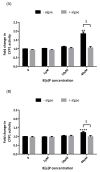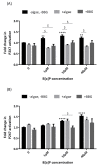In Vitro Chemopreventive Potential of Phlorotannins-Rich Extract from Brown Algae by Inhibition of Benzo[a]pyrene-Induced P2X7 Activation and Toxic Effects
- PMID: 33466689
- PMCID: PMC7828825
- DOI: 10.3390/md19010034
In Vitro Chemopreventive Potential of Phlorotannins-Rich Extract from Brown Algae by Inhibition of Benzo[a]pyrene-Induced P2X7 Activation and Toxic Effects
Abstract
Phlorotannins are polyphenols occurring exclusively in some species of brown algae, known for numerous biological activities, e.g., antioxidant, antiproliferative, antidiabetic, and antiallergic properties. Their effects on the response of human lung cells to benzo[a]pyrene (B[a]P) has not been characterized. Our objective was to in vitro evaluate the effects of a phlorotannin-rich extract obtained from the brown algae Ascophyllum nodosum and Fucus vesiculosus on B[a]P cytotoxic effects. The A549 cell line was incubated with B[a]P for 48 and 72 h in the presence or absence of the brown algae extract. Cytochrome P450 activity, activation of P2X7 receptor, F-actin disorganization, and loss of E-cadherin expression were assessed using microplate cytometry and fluorescence microscopy. Relative to control, incubation with the brown algae extract was associated with lower B[a]P-induced CYP1 activity, lower P2X7 receptor activation, and lower reactive oxygen species production. The brown algae extract inhibited the alterations of F-actin arrangement and the downregulation of E-cadherin expression. We identified a phlorotannins-rich extract that could be deeper investigated as a cancer chemopreventive agent to block B[a]P-mediated carcinogenesis.
Keywords: A549 cells; P2X7 receptor; cancer; cytoskeleton; phlorotannins; pollution.
Conflict of interest statement
M.D. and R.F. are employees of Yslab; E.O., S.F., R.M., K.H., E.R., and P.R. have no conflict of interest.
Figures





Similar articles
-
Profiling phlorotannins in brown macroalgae by liquid chromatography-high resolution mass spectrometry.Phytochem Anal. 2012 Sep-Oct;23(5):547-53. doi: 10.1002/pca.2354. Epub 2012 Mar 2. Phytochem Anal. 2012. PMID: 22383068
-
Structure dependent antioxidant capacity of phlorotannins from Icelandic Fucus vesiculosus by UHPLC-DAD-ECD-QTOFMS.Food Chem. 2018 Feb 1;240:904-909. doi: 10.1016/j.foodchem.2017.08.032. Epub 2017 Aug 10. Food Chem. 2018. PMID: 28946360
-
Identification of Phlorotannins in the Brown Algae, Saccharina latissima and Ascophyllum nodosum by Ultra-High-Performance Liquid Chromatography Coupled to High-Resolution Tandem Mass Spectrometry.Molecules. 2020 Dec 23;26(1):43. doi: 10.3390/molecules26010043. Molecules. 2020. PMID: 33374856 Free PMC article.
-
Anti-diabetic effects of brown algae derived phlorotannins, marine polyphenols through diverse mechanisms.Fitoterapia. 2013 Apr;86:129-36. doi: 10.1016/j.fitote.2013.02.013. Epub 2013 Mar 4. Fitoterapia. 2013. PMID: 23466874 Review.
-
Pharmacological Applications of Phlorotannins: A Comprehensive Review.Curr Drug Discov Technol. 2021;18(2):282-292. doi: 10.2174/1570163817666200206110243. Curr Drug Discov Technol. 2021. PMID: 32026778 Review.
Cited by
-
The Impact of Natural Deep Eutectic Solvents and Extraction Method on the Co-Extraction of Trace Metals from Fucus vesiculosus.Mar Drugs. 2022 May 13;20(5):324. doi: 10.3390/md20050324. Mar Drugs. 2022. PMID: 35621975 Free PMC article.
-
Marine Compounds and Cancer: Updates 2022.Mar Drugs. 2022 Dec 1;20(12):759. doi: 10.3390/md20120759. Mar Drugs. 2022. PMID: 36547906 Free PMC article.
-
A Bioactive Substance Derived from Brown Seaweeds: Phlorotannins.Mar Drugs. 2022 Nov 26;20(12):742. doi: 10.3390/md20120742. Mar Drugs. 2022. PMID: 36547889 Free PMC article. Review.
-
Phlorotannins: Novel Orally Administrated Bioactive Compounds That Induce Mitochondrial Dysfunction and Oxidative Stress in Cancer.Antioxidants (Basel). 2023 Sep 7;12(9):1734. doi: 10.3390/antiox12091734. Antioxidants (Basel). 2023. PMID: 37760037 Free PMC article. Review.
-
Pregnant Women and Endocrine Disruptors: Role of P2X7 Receptor and Mitochondrial Alterations in Placental Cell Disorders.Cells. 2022 Jan 31;11(3):495. doi: 10.3390/cells11030495. Cells. 2022. PMID: 35159304 Free PMC article.
References
-
- Bostrom C.E., Gerde P., Hanberg A., Jernstrom B., Johansson C., Kyrklund T., Rannug A., Tornqvist M., Victorin K., Westerholm R. Cancer risk assessment, indicators, and guidelines for polycyclic aromatic hydrocarbons in the ambient air. Environ. Health Perspect. 2002;110(Suppl. 3):451–488. - PMC - PubMed
MeSH terms
Substances
LinkOut - more resources
Full Text Sources
Other Literature Sources

